Study of a Double-Layer Trombe Wall Assisted by a Temperature-Controlled DC Fan for Heating Seasons
Abstract
:1. Introduction
2. Method
2.1. Office Building Description
2.2. Description of the Double-Layer Trombe Wall with a Temperature-Controlled DC Fan
2.3. Software, Weather, and Location
3. Results
3.1. The Double-Layer Trombe Wall Assisted by a Temperature-Controlled DC Fan Without Air Conditioning
3.2. The Double-Layer Trombe Wall Assisted by a Temperature-Controlled DC Fan on Heating Load Reduction
4. Discussion
5. Conclusions
Acknowledgments
Author Contributions
Conflicts of Interest
References
- Morse, E.S. Warming and Ventilating Apartments by the Sun S Rays. U.S. Patent 246626 A, 11 April 1881. [Google Scholar]
- Birkeland, J. Positive Development: From Vicious Circles to Virtuous Cycles through Built Environment Design; Routledge: London, UK, 2012. [Google Scholar]
- Saadatian, O.; Sopian, K.; Lim, C.H.; Asim, N.; Sulaiman, M.Y. Trombe walls: A review of opportunities and challenges in research and development. Renew. Sustain. Energy Rev. 2012, 16, 6340–6351. [Google Scholar] [CrossRef]
- Binggeli, C. Building Systems for Interior Designers; John Wiley & Sons: Hoboken, NJ, USA, 2003. [Google Scholar]
- Omrany, H.; Ghaffarianhoseini, A.; Ghaffarianhoseini, Am.; Raahemifar, K.; Tookey, J. Application of passive wall systems for improving the energy efficiency in buildings: A comprehensive review. Renew. Sustain. Energy Rev. 2016, 62, 1252–1269. [Google Scholar] [CrossRef]
- Yedder, R.B.; Bilgen, E. Natural convection and conduction in Trombe wall systems. Int. J. Heat Mass Transf. 1991, 34, 1237–1248. [Google Scholar] [CrossRef]
- Rabani, M.; Kalantar, V.; Rabani, M. Heat transfer analysis of a Trombe wall with a projecting channel design. Energy 2017, 134, 943–950. [Google Scholar] [CrossRef]
- Hernández-López, I.; Xamán, J.; Chávez, Y.; Hernández-Pérez, I.; Alvarado-Juárez, R. Thermal energy storage and losses in a room-Trombe wall system located in Mexico. Energy 2016, 109, 512–524. [Google Scholar] [CrossRef]
- Hassanain, A.A.; Hokam, E.M.; Mallick, T.K. Effect of solar storage wall on the passive solar heating constructions. Energy Build. 2011, 43, 737–747. [Google Scholar] [CrossRef]
- Yu, B.; He, W.; Li, N.; Wang, L.; Cai, J.; Chen, H.; Ji, J.; Xu, G. Experimental and numerical performance analysis of a TC-Trombe wall. Appl. Energy 2017, 206, 70–82. [Google Scholar] [CrossRef]
- Briga-Sá, A.; Martins, A.; Boaventura-Cunha, J.; Lanzinha, J.C.; Paiva, A. Energy performance of Trombe walls: Adaptation of ISO 13790:2008(E) to the Portuguese reality. Energy Build. 2014, 74, 111–119. [Google Scholar] [CrossRef]
- Chan, H.-Y.; Riffat, S.B.; Zhu, J. Review of passive solar heating and cooling technologies. Renew. Sustain. Energy Rev. 2010, 14, 781–789. [Google Scholar] [CrossRef]
- Hu, Z.; He, W.; Ji, J.; Zhang, S. A review on the application of Trombe wall system in buildings. Renew. Sustain. Energy Rev. 2017, 70, 976–987. [Google Scholar] [CrossRef]
- Zalewski, L.; Lassue, S.; Duthoit, B.; Butez, M. Study of solar walls—Validating a simulation model. Build. Environ. 2002, 37, 109–121. [Google Scholar] [CrossRef]
- Shen, J.; Lassue, S.; Zalewski, L.; Huang, D. Numerical study of classical and composite solar walls by TRNSYS. J. Therm. Sci. 2007, 16, 46–55. [Google Scholar] [CrossRef]
- Zalewski, L.; Joulin, A.; Lassue, S.; Dutil, Y.; Rousse, D. Experimental study of small-scale solar wall integrating phase change material. Solar Energy 2012, 86, 208–219. [Google Scholar] [CrossRef]
- Shen, J.; Lassue, S.; Zalewski, L.; Huang, D. Numerical study on thermal behavior of classical or composite Trombe solar walls. Energy Build. 2007, 39, 962–974. [Google Scholar] [CrossRef]
- Zalewski, L.; Chantant, M.; Lassue, S.; Duthoit, B. Experimental thermal study of a solar wall of composite type. Energy Build. 1997, 25, 7–18. [Google Scholar] [CrossRef]
- Jaber, S.; Ajib, S. Optimum design of Trombe wall system in mediterranean region. Solar Energy 2011, 85, 1891–1898. [Google Scholar] [CrossRef]
- Yilmaz, Z.; Basak Kundakci, A. An approach for energy conscious renovation of residential buildings in Istanbul by Trombe wall system. Build. Environ. 2008, 43, 508–517. [Google Scholar] [CrossRef]
- Hami, K.; Draoui, B.; Hami, O. The thermal performances of a solar wall. Energy 2012, 39, 11–16. [Google Scholar] [CrossRef]
- Leang, E.; Tittelein, P.; Zalewski, L.; Lassue, S. Numerical study of a composite Trombe solar wall integrating microencapsulated PCM. Energy Procedia 2017, 122, 1009–1014. [Google Scholar] [CrossRef]
- Djordjević, A.V.; Radosavljević, J.M.; Vukadinović, A.V.; Nikolić, J.R.M. Estimation of Indoor Temperature for a Passive Solar Building with a Combined Passive Solar System. J. Energy Eng. 2017, 143, 04017008. [Google Scholar] [CrossRef]
- Hong, X.; He, W.; Hu, Z.; Wang, C.; Ji, J. Three-dimensional simulation on the thermal performance of a novel Trombe wall with venetian blind structure. Energy Build. 2015, 89, 32–38. [Google Scholar] [CrossRef]
- Abbassi, F.; Dimassi, N.; Dehmani, L. Energetic study of a Trombe wall system under different Tunisian building configurations. Energy Build. 2014, 80, 302–308. [Google Scholar] [CrossRef]
- Sun, W.; Ji, J.; Luo, C.; He, W. Performance of PV-Trombe wall in winter correlated with south façade design. Appl. Energy 2011, 88, 224–231. [Google Scholar] [CrossRef]
- Dragićević, S.M.; Lambić, M.R. Numerical study of a modified Trombe wall solar collector system. Therm. Sci. 2009, 13, 195–204. [Google Scholar] [CrossRef]
- Soussi, M.; Balghouthi, M.; Guizani, A. Energy performance analysis of a solar-cooled building in Tunisia: Passive strategies impact and improvement techniques. Energy Build. 2013, 67, 374–386. [Google Scholar] [CrossRef]
- Dragićević, S.; Lambic, M. Influence of constructive and operating parameters on a modified Trombe wall efficiency. Arch. Civ. Mech. Eng. 2011, 11, 825–838. [Google Scholar] [CrossRef]
- Briga-Sá, A.; Boaventura-Cunha, J.; Lanzinha, J.-C.; Paiva, A. Experimental and analytical approach on the Trombe wall thermal performance parameters characterization. Energy Build. 2017, 150, 262–280. [Google Scholar] [CrossRef]
- Briga-Sá, A.; Boaventura-Cunha, J.; Lanzinha, J.-C.; Paiva, A. An experimental analysis of the Trombe wall temperature fluctuations for high range climate conditions: Influence of ventilation openings and shading devices. Energy Build. 2017, 138, 546–558. [Google Scholar] [CrossRef]
- Bellos, E.; Tzivanidis, C.; Zisopoulou, E.; Mitsopoulos, G.; Antonopoulos, K.A. An innovative Trombe wall as a passive heating system for a building in Athens—A comparison with the conventional Trombe wall and the insulated wall. Energy Build. 2016, 133, 754–769. [Google Scholar] [CrossRef]
- Corasaniti, S.; Manni, L.; Russo, F.; Gori, F. Numerical simulation of modified Trombe-Michel Walls with exergy and energy analysis. Int. Commun. Heat Mass Transf. 2017, 88, 269–276. [Google Scholar] [CrossRef]
- Jovanovic, J.; Sun, X.; Stevovic, S.; Chen, J. Energy-efficiency gain by combination of PV modules and Trombe wall in the low-energy building design. Energy Build. 2017, 152, 568–576. [Google Scholar] [CrossRef]
- Sebald, A.; Clinton, J.; Langenbacher, F. Performance effects of Trombe wall control strategies. Solar Energy 1979, 23, 479–487. [Google Scholar] [CrossRef]
- Sebald, A. Efficient simulation of large, controlled passive solar systems: Forward differencing in thermal networks. Solar Energy 1985, 34, 221–230. [Google Scholar] [CrossRef]
- Jie, J.; Hua, Y.; Gang, P.; Bin, J.; Wei, H. Study of PV-Trombe wall assisted with DC fan. Build. Environ. 2007, 42, 3529–3539. [Google Scholar] [CrossRef]
- Lee, H.; Ozaki, A.; Lee, M. Energy saving effect of air circulation heat storage system using natural energy. Build. Environ. 2017, 124, 104–117. [Google Scholar] [CrossRef]
- Ozaki, A.; Watanabe, T.; Hayashi, T.; Ryu, Y. Systematic analysis on combined heat and water transfer through porous materials based on thermodynamic energy. Energy Build. 2001, 33, 341–350. [Google Scholar] [CrossRef]
- Ozaki, A.; Watanabe, T.; Takase, S. Simulation software of the hydrothermal environment of buildings based on detailed thermodynamic models. In Proceedings of the ESim 2004 Canadian Conference on Building Energy Simulation, Vancouver, BC, Canada, 10–11 June 2004. [Google Scholar]
- Data, E.A.W. Data 1981–2000; Architectural Institute of Japan: Tokyo, Japan, 2003. [Google Scholar]
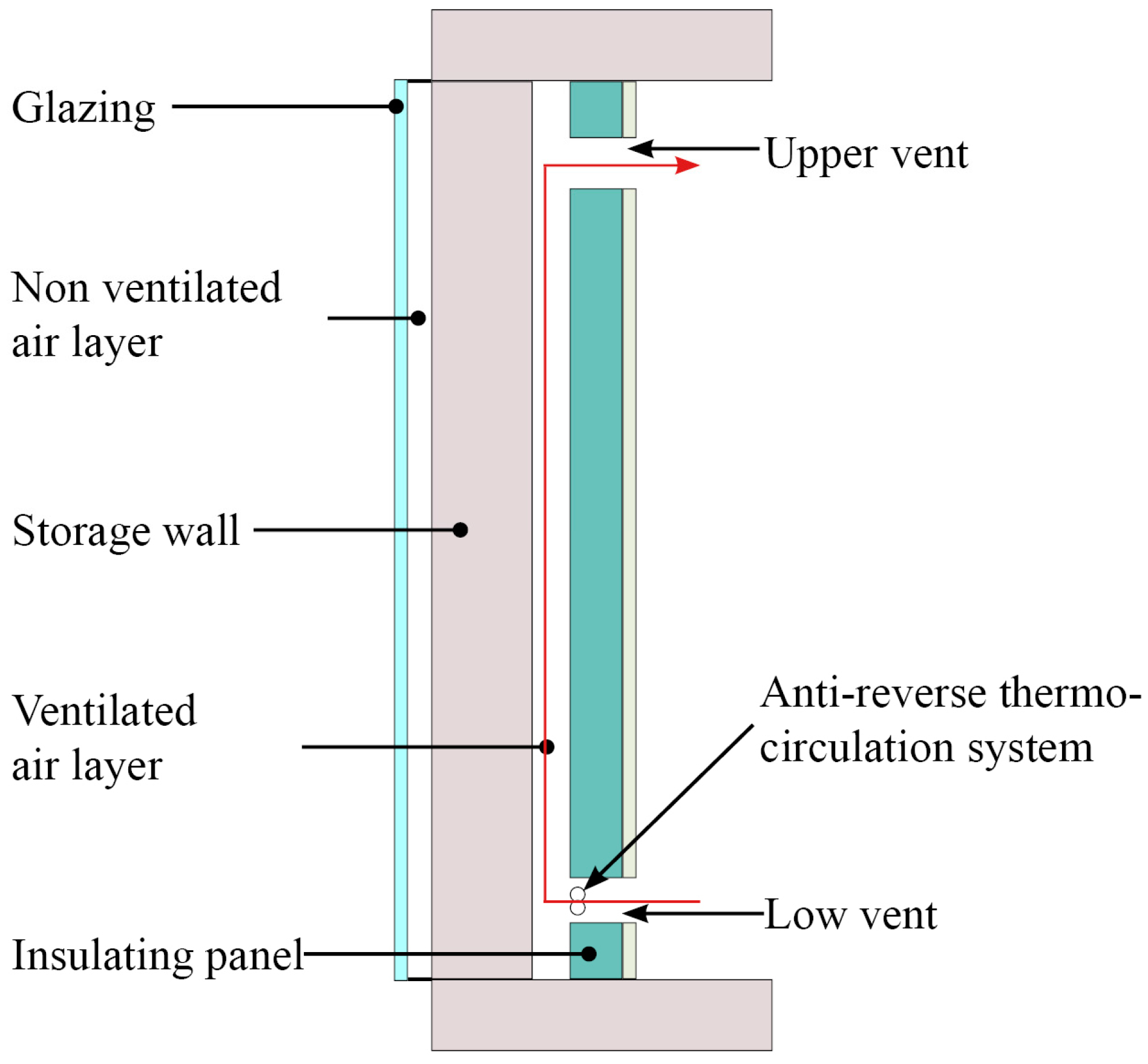



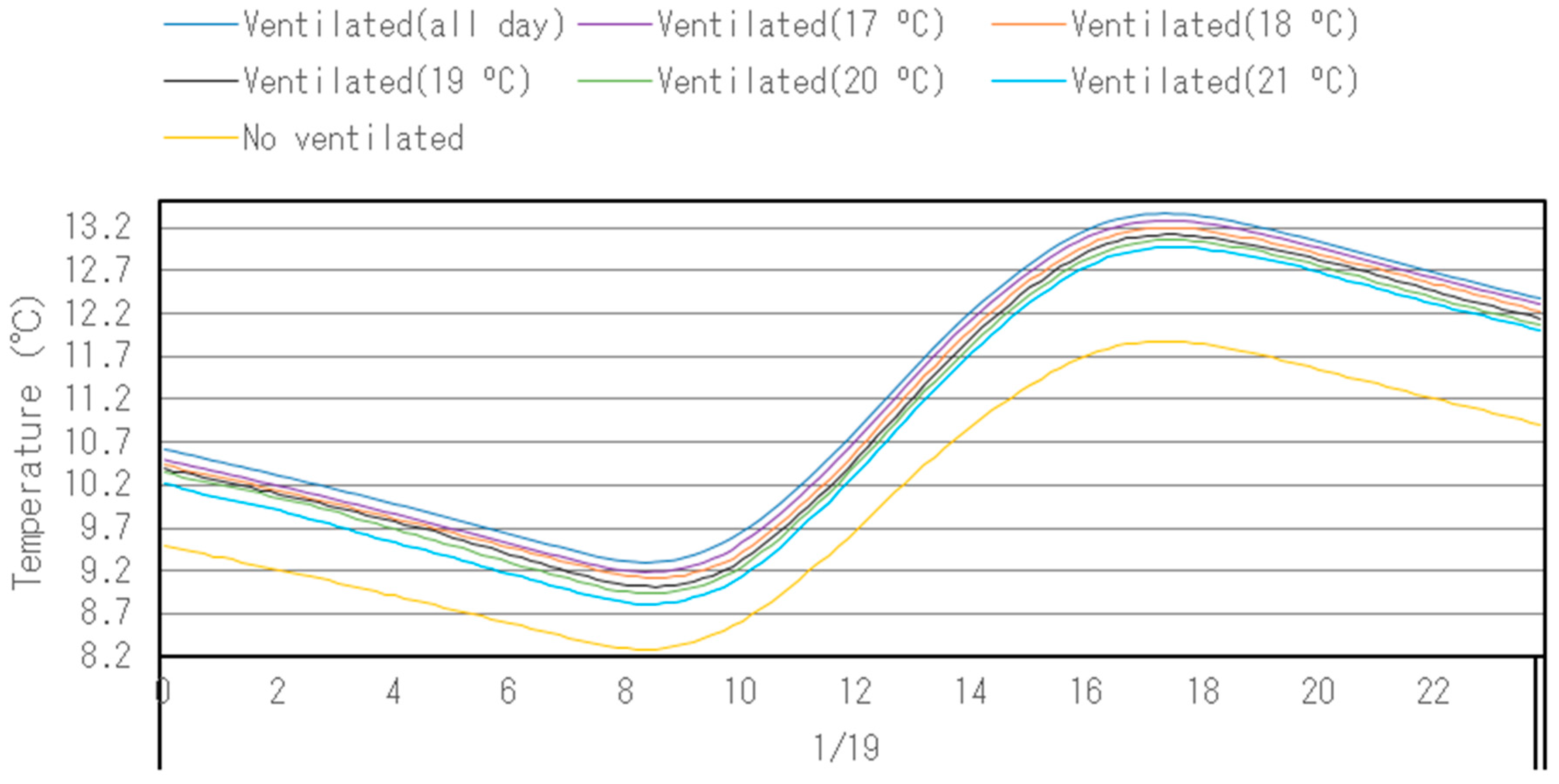
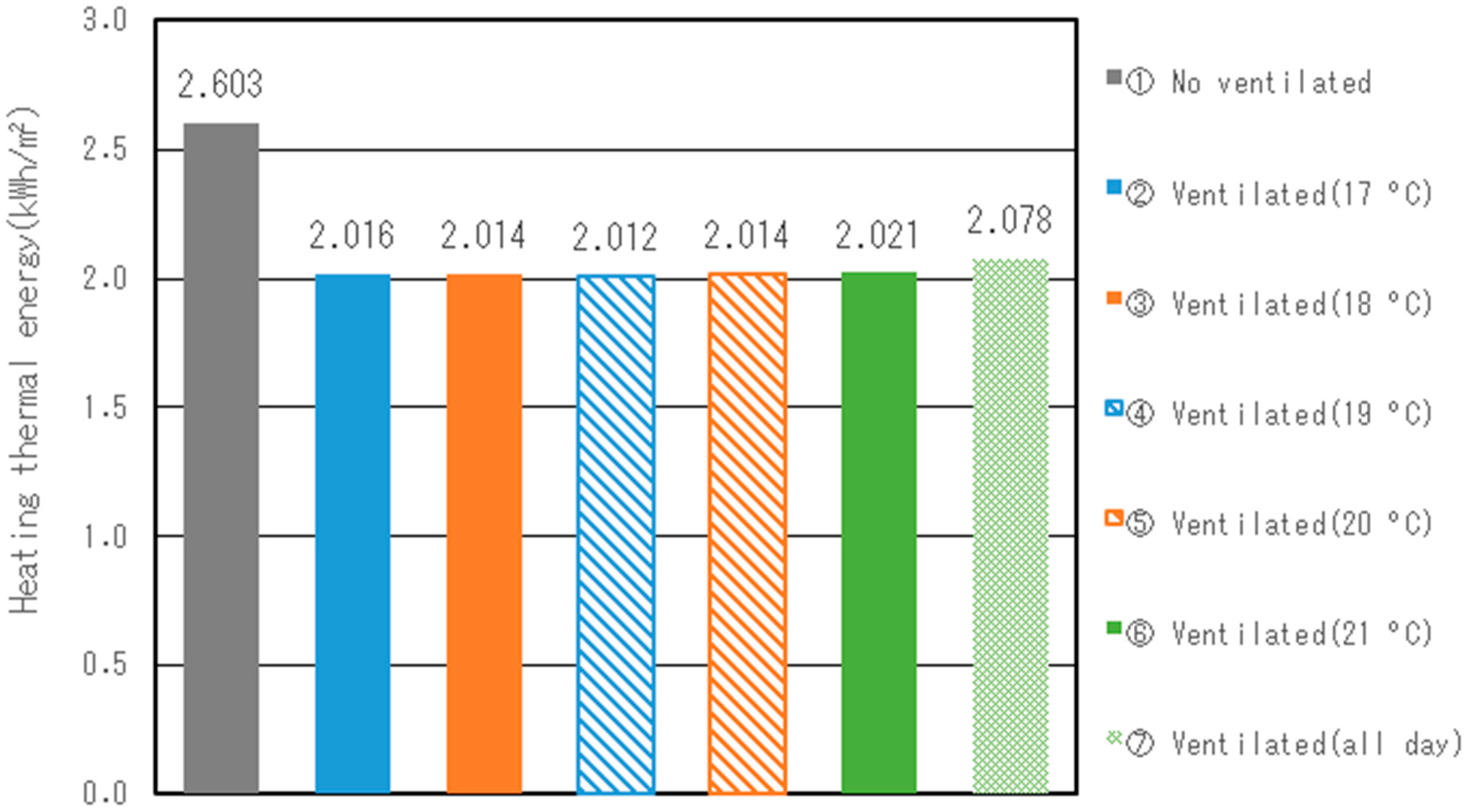
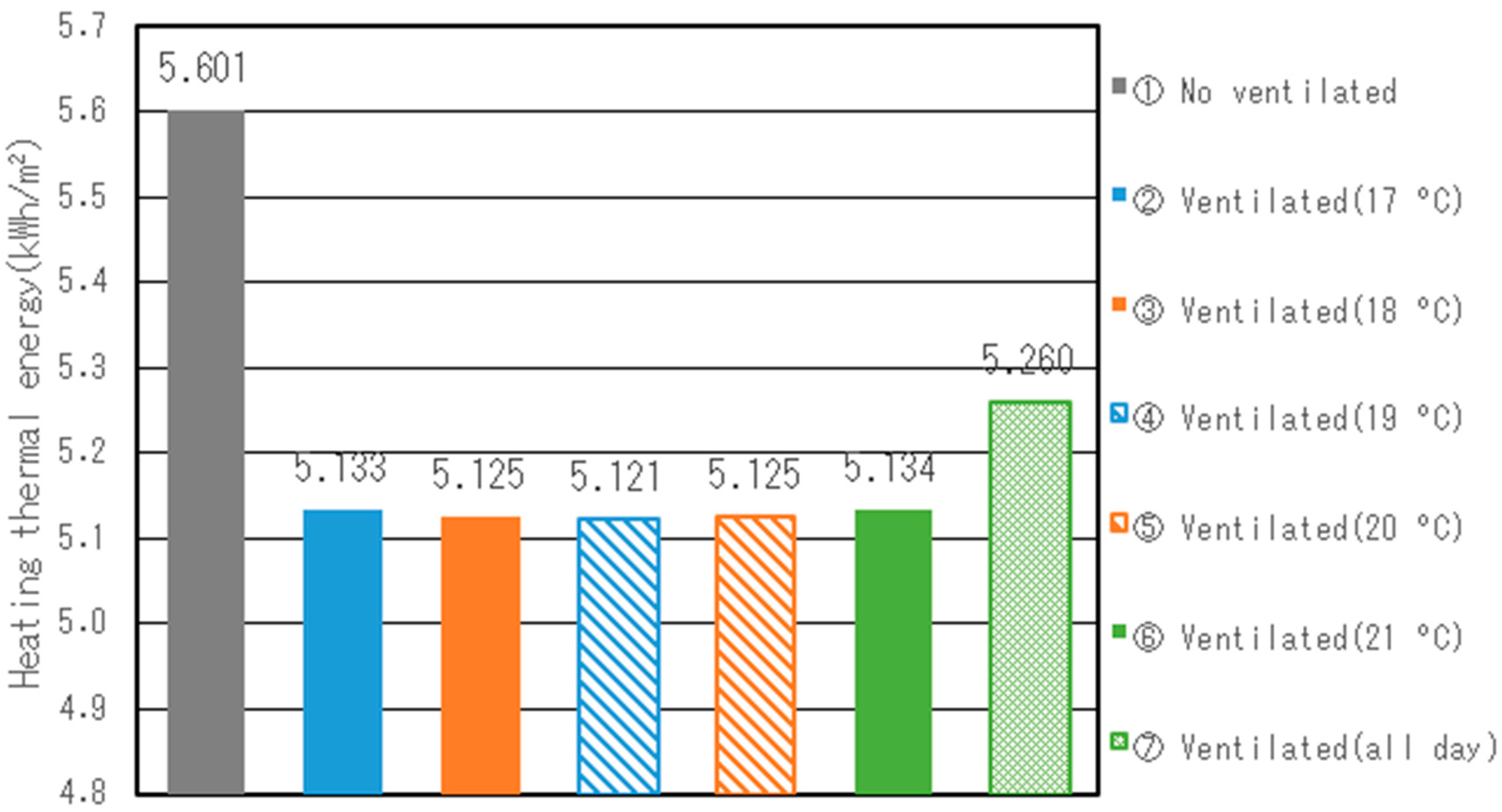
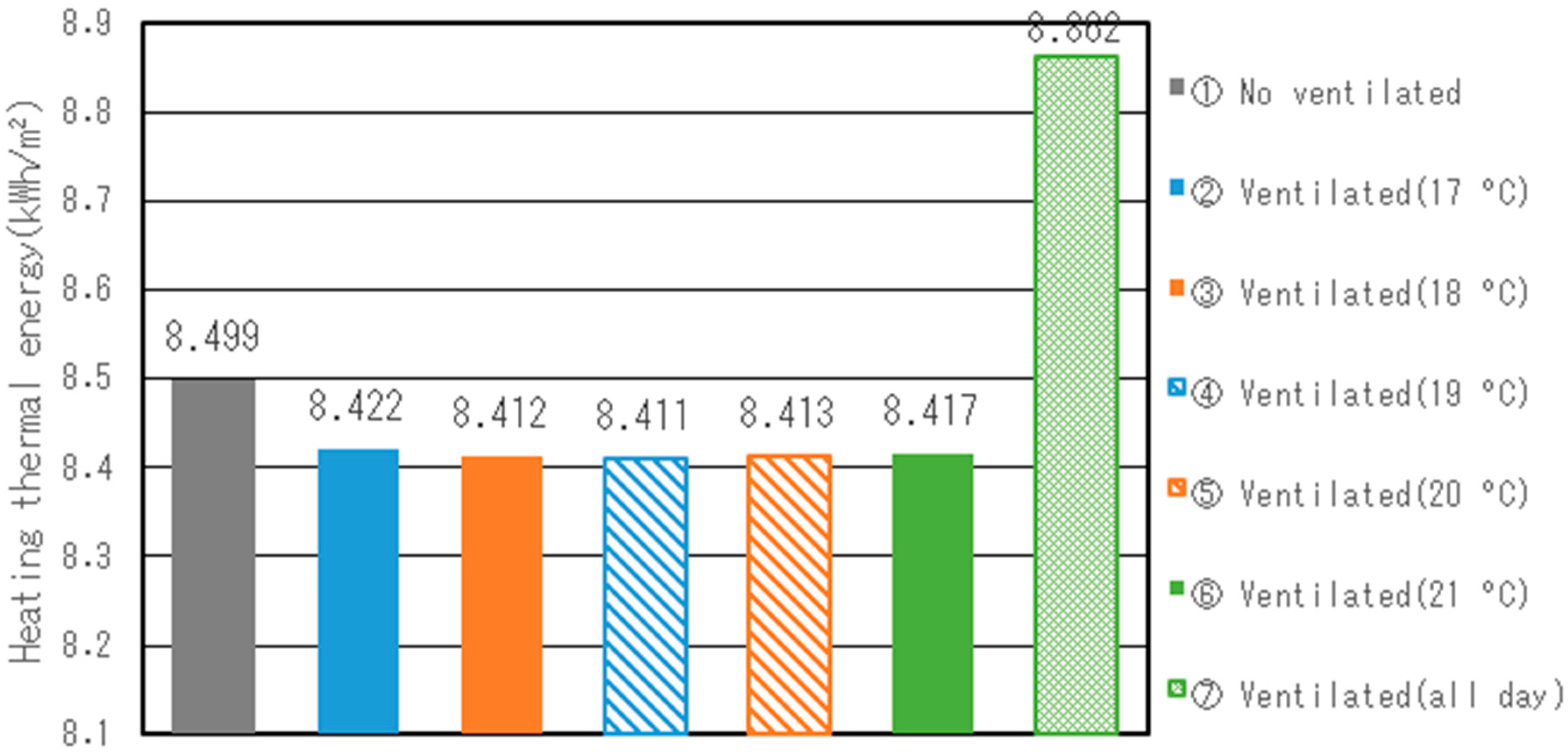
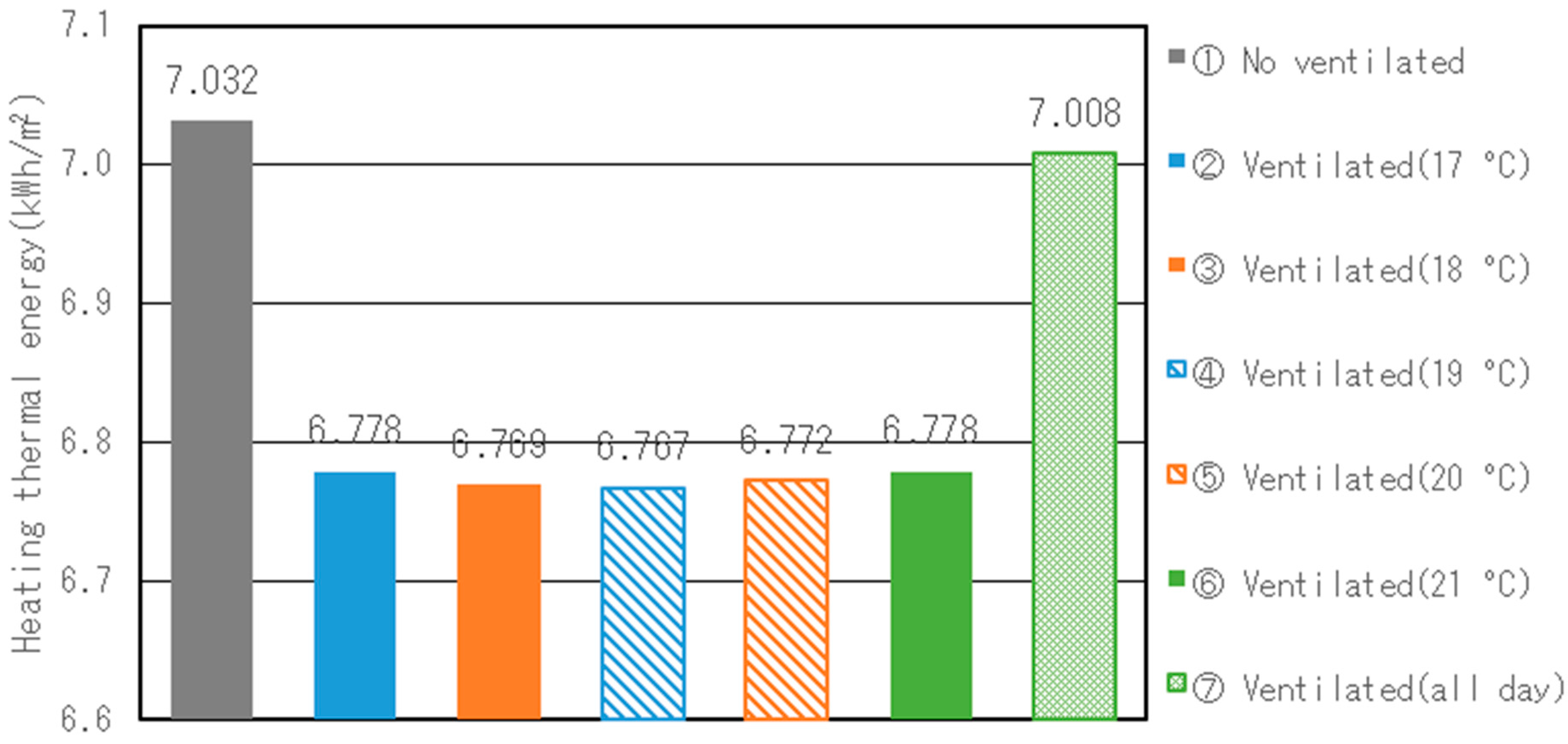

| Layer | Layer | Thickness (m) | λ (W/m K) | p (kg/m3) | cp (J/kg K) |
|---|---|---|---|---|---|
| Double glazing | Glass | 0.004 | 0.78 | 2540 | 770 |
| Air | 0.012 | 0.22 | 1.2 | 1000 | |
| Glass | 0.004 | 0.78 | 2540 | 770 | |
| Outer-ventilated air | Air | 0.35 | |||
| Massive wall | Concrete | 0.35 | 1.6 | 2200 | 840 |
| Inner-ventilated air | Air | 0.065 | |||
| Insulation | Glass wool | 0.4 | 0.03 | 16 | 840 |
| Gypsum board | 0.012 | 0.22 | 700 | 870 |
© 2017 by the authors. Licensee MDPI, Basel, Switzerland. This article is an open access article distributed under the terms and conditions of the Creative Commons Attribution (CC BY) license (http://creativecommons.org/licenses/by/4.0/).
Share and Cite
Ma, Q.; Fukuda, H.; Kobatake, T.; Lee, M. Study of a Double-Layer Trombe Wall Assisted by a Temperature-Controlled DC Fan for Heating Seasons. Sustainability 2017, 9, 2179. https://doi.org/10.3390/su9122179
Ma Q, Fukuda H, Kobatake T, Lee M. Study of a Double-Layer Trombe Wall Assisted by a Temperature-Controlled DC Fan for Heating Seasons. Sustainability. 2017; 9(12):2179. https://doi.org/10.3390/su9122179
Chicago/Turabian StyleMa, Qingsong, Hiroatsu Fukuda, Takumi Kobatake, and Myonghyang Lee. 2017. "Study of a Double-Layer Trombe Wall Assisted by a Temperature-Controlled DC Fan for Heating Seasons" Sustainability 9, no. 12: 2179. https://doi.org/10.3390/su9122179





